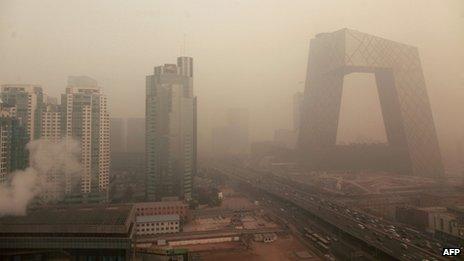Beijing releases air pollution data
- Published

High levels of air pollution in the Chinese capital frequently affect visibility
Authorities in the Chinese capital Beijing have started releasing more detailed data on air quality.
It comes in response to public criticism of levels of pollution and official openness about measuring it.
Beijing previously released levels of air-borne PM10 - particles equal to or less than 10 microns across.
But officials on Saturday released data for PM2.5, smaller particles which can penetrate deep into the lungs and are seen as better indicators of pollution.
An online campaign calling for reform of the monitoring system in Beijing was launched last year, and received widespread support.
The US Embassy in Beijing measures PM2.5 levels using a device on its rooftop, and releases the information hourly via Twitter, external. Its assessment of air quality has often differed from that of Beijing's authorities.
Health worries
Beijing's environmental monitoring centre has now started posting PM2.5 readings on its website, releasing initially hourly readings from one monitoring site in Xicheng district.
The data released on Saturday suggested the city's air quality was good, containing 0.003 micrograms of PM2.5 per cubic metre.
Correspondents say Beijing's often poor air quality has left authorities with some serious credibility problems.
Residents are demanding more information about air pollution and its effects on their health.
Beijing's location, on a flat plain surrounded by mountains on three sides, and the high level of traffic, means that it is particularly prone to air pollution and smog.
State news agency Xinhua quotes Yu Jianhua, external, from the Beijing Environmental Protection Bureau, as saying that the city government had spent the last ten years taking "aggressive air pollution control measures" in the hope of meeting the national PM10 standard of 100 micrograms per cubic meter of air.
However, the average PM10 reading in the Chinese capital last year was 120 micrograms, Xinhua reports.
- Published6 January 2012
- Published7 December 2011
- Published6 December 2011
- Published31 July 2011